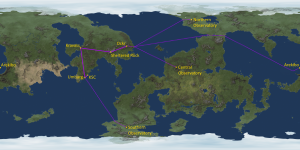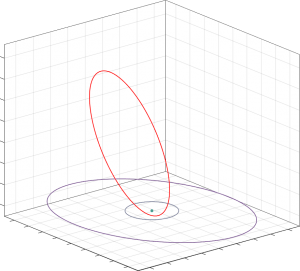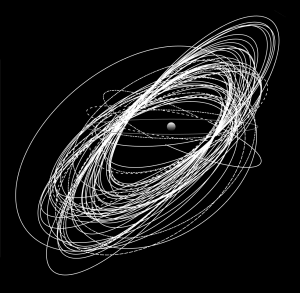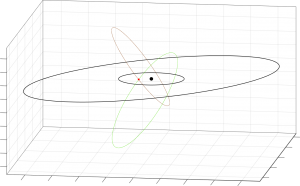|
Tag Archive: ATN
Nov 17 2017
Operations Summary – Week of 11/13/17
Nov 14 2017
Alaba Orbital Propagation Report
The Asteroid Tracking Network discovered a new companion of Kerbin last week as the asteroid originally designated KUH-563(C) flew through Mun’s SOI while scopes were keeping a close eye on it for just such a passage. A few days later after more observations to nail down its orbit the Kerbin Astronomical Society made the formal announcement of the new moonlet, dubbed Alaba, which is ancient Kerbskrit for “second child”. Technically this is the 5th detected moonlet of Kerbin but in relation to our only other current companion Chikelu, the name fits.
The observed orbit of Alaba showed that it had to have been a resident of the Kerbin system for several weeks to several months already. The eccentricity of its current orbit is 0.46, which is too small to be an original capture orbit. Over several encounters with Mun the asteroid has slowly developed a smaller and more circular orbit. How many? We don’t know and probably never will. The fact that it’s been around for a while though does make one wonder what else might be nearby we haven’t spotted yet!
After the initial orbit was locked down the data was plugged into the trajectory analysis tool we use here at the KSA to determine how Alaba would behave on future Mun encounters to try and predict its eventual fate. A captured object like this has three options: crash into Kerbin, crash into Mun or get ejected back out of the system. After 58 more encounters is looks as if Alaba will eventually smash into the southern hemisphere of Mun in early 2021.
May 10 2017
Deep Space Network Sites Chosen
 Over the next 3-4 years we will be working with the Asteroid Tracking Network and the Kerbal Astronomical Society in addition to several companies and private investors to set up 4 new observatories around Kerbin for both optical and radio astronomy, which will also assist us in communicating with spacecraft beyond the Kerbin system. The first, which is already about to begin construction this month after several delays, will be the massive Arekibo Radio Observatory that will reside in the uplift island in the center of Sea Ring Crater. With a dish 200m in diameter (originally planned to be only 180m) it will be the foremost radio telescope on the entire planet and dedicated entirely to this form of astronomical observation. Although it sits in a huge bowl that cannot be moved, the receiver apparatus itself can be translated, allowing it to cover more sky than simply straight up. Arekibo is planned to become operational in mid-2018
Over the next 3-4 years we will be working with the Asteroid Tracking Network and the Kerbal Astronomical Society in addition to several companies and private investors to set up 4 new observatories around Kerbin for both optical and radio astronomy, which will also assist us in communicating with spacecraft beyond the Kerbin system. The first, which is already about to begin construction this month after several delays, will be the massive Arekibo Radio Observatory that will reside in the uplift island in the center of Sea Ring Crater. With a dish 200m in diameter (originally planned to be only 180m) it will be the foremost radio telescope on the entire planet and dedicated entirely to this form of astronomical observation. Although it sits in a huge bowl that cannot be moved, the receiver apparatus itself can be translated, allowing it to cover more sky than simply straight up. Arekibo is planned to become operational in mid-2018
Feb 10 2017
Third Moonlet of Kerbin Captured… by Kerbin?
 Today the Asteroid Tracking Network revealed that a third moonlet had been discovered in one of its sky surveys and after several nights of study astronomers have determined its orbit well enough to declare their findings. The new moonlet, which was designated by the ATN as ICX-922(A) is the smallest object yet to be captured, massing in at a mere 101.790t, or 0.08% the mass of DGU-266(B) and 0.0007% the mass of Meeny (which is a Class-C asteroid). The circumstances under which this object were captured are only theorized, given that it did not involve the usual suspect, Mun. In the case of both Meeny and DGU-266(B) (naming suggestions are still being taken!) Mun got in the way of their trajectory through the Kerbin system and as it passed them it pulled at them with its gravity, slowing down their velocities enough to remain in orbit around Kerbin.
Today the Asteroid Tracking Network revealed that a third moonlet had been discovered in one of its sky surveys and after several nights of study astronomers have determined its orbit well enough to declare their findings. The new moonlet, which was designated by the ATN as ICX-922(A) is the smallest object yet to be captured, massing in at a mere 101.790t, or 0.08% the mass of DGU-266(B) and 0.0007% the mass of Meeny (which is a Class-C asteroid). The circumstances under which this object were captured are only theorized, given that it did not involve the usual suspect, Mun. In the case of both Meeny and DGU-266(B) (naming suggestions are still being taken!) Mun got in the way of their trajectory through the Kerbin system and as it passed them it pulled at them with its gravity, slowing down their velocities enough to remain in orbit around Kerbin.
The leading theory among astronomers is that ICX was traveling leisurely along when Kerbin caught up from behind, causing the asteroid to fall back and around Kerbin while also being carried along, so when it left Kerbin’s SOI it also got a boost, or assist, from our planet’s velocity. But the exit from Kerbin’s SOI may have been more of a “lob” than a “throw”, and the asteroid shortly fell back towards Kerbin but this time it was moving faster and the slower movement of Kerbin dragged its velocity back down far enough that when it was lobbed back out, it didn’t quite make it all the way this time. The apokee of ICX’s highly elliptical orbit rises to 83,495km, which is just 664km short of the SOI boundary.
ICX will undergo much more study in the months to come, and astronomers see no reason why it would be going anywhere anytime soon given that it can’t interact directly with Mun. The Kerbal Astronomical Society will be in charge of selecting a name, although it may decide to go to the public once again.
Feb 02 2017
Second Moonlet of Kerbin Discovered
It was amateur astronomer Remises Kerman’s first attempt to look for Meeny in the night sky with his new high-powered telescope. He had pulled all the data from the Asteroid Tracking Network database and calculated the trajectory so he would know where and when to point his scope. However he didn’t double-check his calculations, or he probably would have noticed the simple arithmetic error that caused him to point his scope at the wrong section of sky and at the wrong time – Meeny was several hours from being visible at that location. Still, he saw something moving against the backdrop of stars and nebulae over the course of 3 hours of watching. Realizing its motion wasn’t in the proper direction for it to be Meeny and that it was traveling too fast to be a distant object, he continued to study the object for the next night and did a rough calculation of its trajectory to confirm it was orbiting Kerbin. He quickly alerted the ATN, who did follow-up observations to confirm the existence of the asteroid, which they cataloged as DGU-266(B) and is now available on our Flight Tracker. It now falls upon the Kerbal Astronomical Society to choose a name for the object. They are considering sourcing names from the public to help increase outreach and interest in astronomy.
The asteroid is currently predicted to skim through Mun’s SOI again shortly on 2/12, after which astronomers will once more turn their scopes on it for a detailed study of its orbit. Everyone who keeps records of the star fields they observe over time is also checking through their archives to see if they can spot DGU in any of them, to possibly give us a time frame for when the asteroid was captured by Mun. Unlike Meeny, we did not see this capture coming ahead of time and due to its low eccentricity, it’s likely been in orbit for a while now. It’s very likely there have been other small moonlets that have come and gone thanks to Mun without our even knowing they were there.
Remises is still hoping to get a look at Meeny through his ‘scope next time it passes around the night side of Kerbin. He’ll double-check his calculations too he says.









